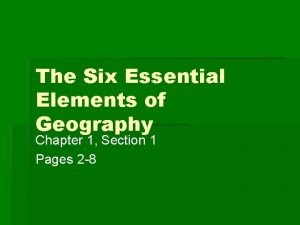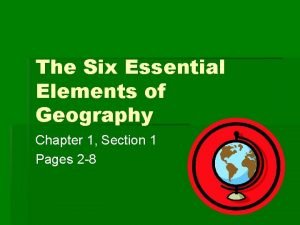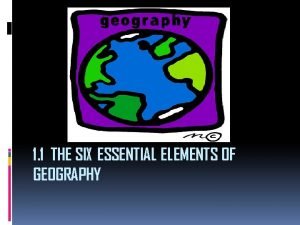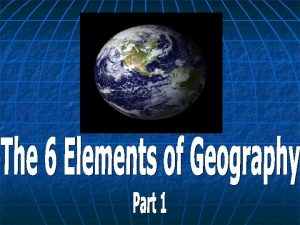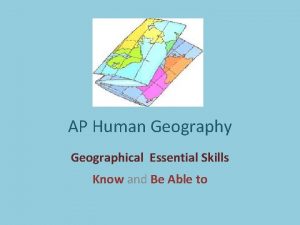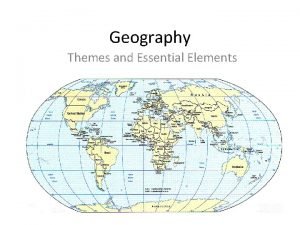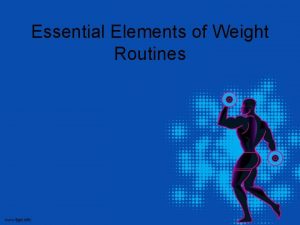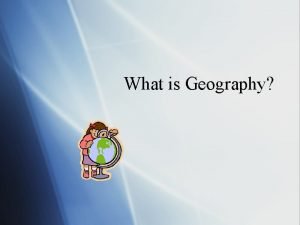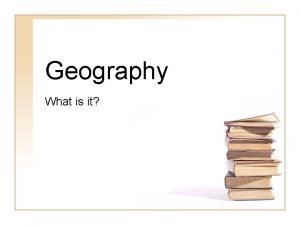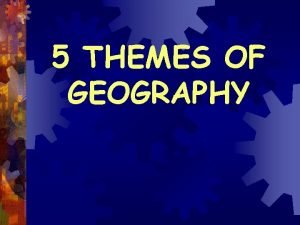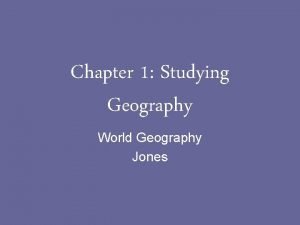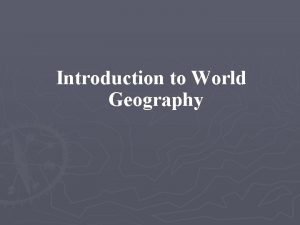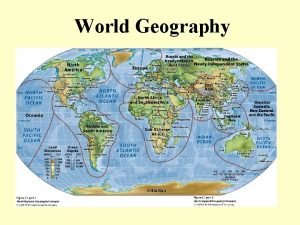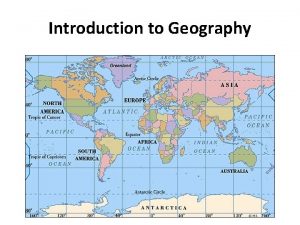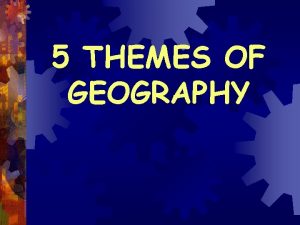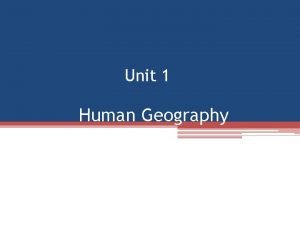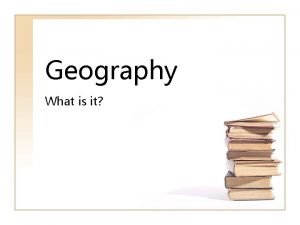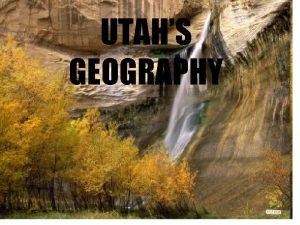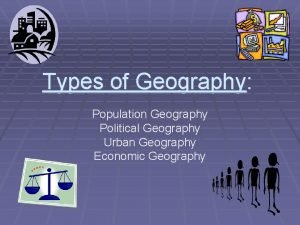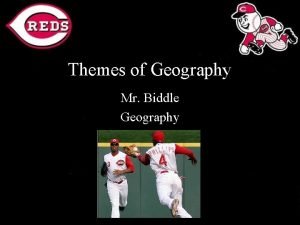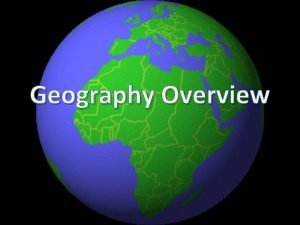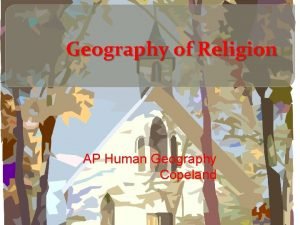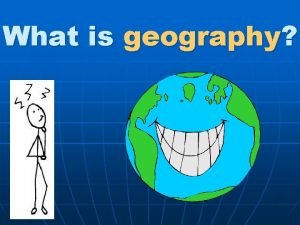The 6 ESSENTIAL ELEMENTS of Geography 6 Essential





























- Slides: 29

The 6 ESSENTIAL ELEMENTS of Geography

6 Essential Elements 1. THE WORLD IN SPATIAL TERMS 2. PLACES & REGIONS 3. PHYSICAL SYSTEMS 4. HUMAN SYSTEMS 5. ENVIRONMENT & SOCIETY

Essential Element #1 THE WORLD IN SPATIAL TERMS Standard 1. How to use maps & other geographic representations, tools, and technologies to acquire, process, and report information from a spatial perspective. Standard 2. How to use mental maps to organize information about people, places, and environments in a spatial context. Standard 3. How to analyze the spatial organization of people, places, and environments on Earth's surface.

I. Location n The place where something is located on the earth's surface.

Location A) Absolute location: – exact “location” or spot where something is found on a map • requires Latitude and Longitude – cuts earth into Hemispheres (2 halves) n Northern & Southern hemispheres n Eastern & Western hemispheres • is known as the Address of location

Location B) Relative location – where a place is in relation to other places n Examples • Sugar Land is SW of Houston • Mrs. Brown’s class is in the 1 st hallway in the Social Studies wing

Essential Element #2 PLACES & REGIONS n n n Standard 4. The physical and human characteristics of places. Standard 5. That people create regions to interpret Earth's complexity. Standard 6. How culture and experience influence people's perceptions of places and regions.

II. Regions n n n Areas united by specific factors How the earth is divided for study. Geographers choose how they will classify the world based on common characteristics.

Regions A) Formal Region A place defined by common characteristics that might include: physical n government n economic n cultural n

FORMAL REGION Examples: n political region such as a city, state or country. People are governed by the same laws and the same government. n The Corn Belt (Iowa/Illinois)

B) Functional Region • A place connected by movement between places. • Example - the greater Houston Metropolitan area, DFW. People move from home-work-home for jobs, entertainment, etc.

Functional Region n n Central place and the surrounding area linked to it Houston and it’s suburbs are linked by highways

C) Perceptual Region • A place defined by popular feelings & images rather than by objective data. • With a perceptual region, the exact area that the region describes can differ based on “perceptions. ” • There is NO real defined area.

PERCEPTUAL REGION Example — the term “Heartland” refers to a central area where traditional values are believed (or perceived) to be predominate. n

III. Place n n answers the question “What is it like? ” Place can be describe in two ways: - Physical and Human • Schools are inside buildings intended for learning • Parks are outside and intended for recreation • Sugar Land is a suburban city with businesses, quality schools, and nice neighborhoods

Essential Element #3 PHYSICAL SYSTEMS n n Standard 7. The physical processes that shape the patterns of Earth's surface. Standard 8. The characteristics and spatial distribution of ecosystems on Earth's surface.

A) Physical Systems • Info about a location based on physical features such as landforms, weather, climate, or vegetation and how they interact with plant & animal life.

Essential Element #4 HUMAN SYSTEMS n n n Standard 9. The characteristics, distribution, and migration of human populations on Earth's surface. Standard 10. The characteristics, distribution, and complexity of Earth's cultural mosaics. Standard 11. The patterns and networks of economic interdependence on Earth's surface.

Essential Element #4 HUMAN SYSTEMS n n n Standard 12. The processes, patterns, and functions of human settlement. Standard 13. How the forces of cooperation & conflict among people influence the division & control of Earth's surface. Standard 14. How human actions modify the physical environment.

B) Human Systems • Information about a location based on how people “shape” the earth. • Elements to consider — population, religion, education, and language.

IV. Movement n The ongoing migration of people and exchange of goods and ideas • Immigration from another country, state, or city • Trade • Spread of religions and ways of life that can transform a place

IV. Movement n The movement of goods, people & ideas from one location to another. A) Goods can be moved by land, air, & water.

Movement n The movement of goods, people & ideas from one location to another. B) People can be physically moved – population trends and location change

Movement n The movement of goods, people & ideas from one location to another. • C) Ideas can be moved from person to person, by the media, through the internet, etc.

Essential Element #5 ENVIRONMENT & SOCIETY n n Standard 15. How physical systems affect human systems. Standard 16. The changes that occur in the meaning, use, distribution, and importance of resources.

V. Human-Environment Interaction A) How humans use, change, or live with their environment. B) Sometimes it is deliberate, but often it is unintentional.

Human-Environment Interaction n Example: • Nomads use to travel from place to place, using the resources available • As people settled they began to farm, cutting down vegetation and altering the environment • People built homes, streets, then cars, etc…

Essential Element #6 VI. THE USES OF GEOGRAPHY n n Standard 17. How to apply geography to interpret the past. Standard 18. How to apply geography to interpret the present and plan for the future.

Essential Element #6 VI. THE USES OF GEOGRAPHY n n A) to interpret the past. B) to interpret the present and plan for the future.
 6 essential elements of geography
6 essential elements of geography The 6 elements of geography
The 6 elements of geography The six elements of geography
The six elements of geography Mrdowling
Mrdowling Six essential elements of geography definitions
Six essential elements of geography definitions Essential non essential fatty acids
Essential non essential fatty acids Essential skills to study geography
Essential skills to study geography How to write an frq for ap human geography
How to write an frq for ap human geography 5 themes of geography ap human geography
5 themes of geography ap human geography Proruption ap human geography
Proruption ap human geography Hát kết hợp bộ gõ cơ thể
Hát kết hợp bộ gõ cơ thể Ng-html
Ng-html Bổ thể
Bổ thể Tỉ lệ cơ thể trẻ em
Tỉ lệ cơ thể trẻ em Gấu đi như thế nào
Gấu đi như thế nào Tư thế worm breton là gì
Tư thế worm breton là gì Chúa yêu trần thế
Chúa yêu trần thế Các môn thể thao bắt đầu bằng từ đua
Các môn thể thao bắt đầu bằng từ đua Thế nào là hệ số cao nhất
Thế nào là hệ số cao nhất Các châu lục và đại dương trên thế giới
Các châu lục và đại dương trên thế giới Công của trọng lực
Công của trọng lực Trời xanh đây là của chúng ta thể thơ
Trời xanh đây là của chúng ta thể thơ Cách giải mật thư tọa độ
Cách giải mật thư tọa độ Làm thế nào để 102-1=99
Làm thế nào để 102-1=99 độ dài liên kết
độ dài liên kết Các châu lục và đại dương trên thế giới
Các châu lục và đại dương trên thế giới Thơ thất ngôn tứ tuyệt đường luật
Thơ thất ngôn tứ tuyệt đường luật Quá trình desamine hóa có thể tạo ra
Quá trình desamine hóa có thể tạo ra Một số thể thơ truyền thống
Một số thể thơ truyền thống Cái miệng bé xinh thế chỉ nói điều hay thôi
Cái miệng bé xinh thế chỉ nói điều hay thôi
